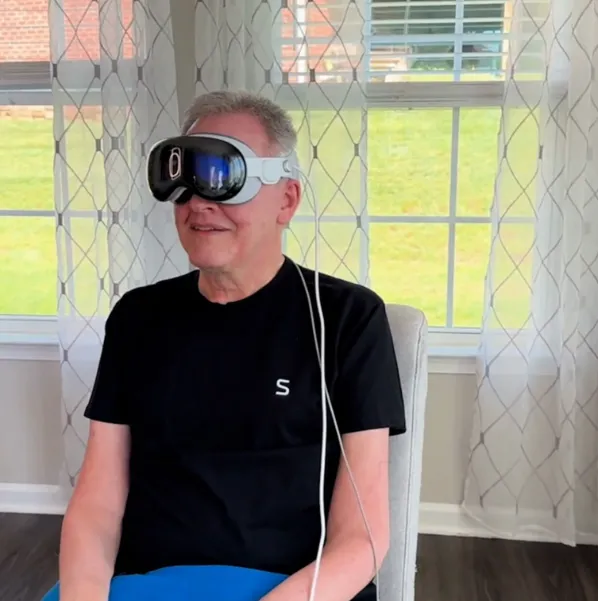Synchron, a pioneering company in the brain-computer interface (BCI) field, has made a historic advancement by integrating its technology with Apple’s Vision Pro. This groundbreaking development marks the world’s first use of an Apple Vision Pro headset controlled by an implantable BCI, offering a new level of accessibility for individuals with severe mobility impairments. A 64-year-old ALS patient in the United States successfully used his thoughts to operate the Vision Pro, demonstrating the immense potential of this technology.
Transforming the Lives of ALS Patients
For Mark, an ALS patient who had lost the use of his limbs, this technological breakthrough was nothing short of life-changing. Using only his brain activity, Mark was able to play Solitaire, watch Apple TV, and send text messages—all without relying on his hands or voice. “This is pretty cool,” Mark commented. “Using this type of enhanced reality is so impactful and can transport you to places you never thought you’d see or experience again.” This achievement underscores the profound impact that brain-controlled technology can have on those who are most in need of accessibility solutions.
How the Synchron BCI and Apple Vision Pro Work Together
Apple’s Vision Pro, a highly innovative spatial computer, traditionally relies on hand gestures, eye tracking, and voice commands for interaction. However, with Synchron’s BCI, brain activity replaces these physical inputs, allowing for hands-free control. The BCI, which is implanted via a minimally invasive procedure, detects motor intent from the brain and wirelessly transmits these signals to the Vision Pro, enabling complete control through thought alone.
Synchron’s BCI system is designed to be intuitive and easy to use, even for individuals with severe paralysis. This seamless integration with the Vision Pro makes it possible for those who once thought such technology was out of reach to engage with digital devices in new, empowering ways. The collaboration between Synchron and Apple Vision Pro marks a significant leap forward in making high-tech devices accessible to a wider range of people.
Apple Vision Pro: A Leap Forward in Digital Interaction
The Apple Vision Pro combines the digital and physical worlds in a way that feels truly immersive, offering an expansive canvas for apps and digital content that transcend the limitations of traditional screens. Typically, Vision Pro uses a combination of hand gestures, voice commands, and eye tracking to control its interface. However, with Synchron’s brain-computer interface, it introduces an entirely new dimension of control, relying on direct brain signals to operate the device.
Synchron’s CEO, Tom Oxley, emphasized the importance of this breakthrough: “We are moving towards a new Bluetooth standard for Human-Computer Interactions that don’t require touch or speech. This is a critical unmet need for millions of people with paralysis.” This new mode of interaction paves the way for more inclusive and accessible technology, ensuring that people with mobility challenges can enjoy the benefits of cutting-edge devices like the Vision Pro.
A New Era for Accessibility in Consumer Technology
The successful integration of Synchron’s BCI with Apple Vision Pro has set a new benchmark for accessibility in consumer technology. By allowing people with disabilities to engage with advanced tech using only their brain signals, this innovation opens up a wide range of possibilities for individuals who previously had limited access to such devices. This development not only transforms the lives of those with paralysis but also sets the stage for future applications of BCIs in everyday technology, from smartphones to smart home devices.
This collaboration between Synchron and Apple is a significant step forward in ensuring that groundbreaking technology is accessible to all, regardless of physical limitations. As BCI technology continues to evolve, it holds the potential to make even more aspects of life and technology accessible to people with disabilities, further bridging the gap between the physical and digital worlds.
